Race Report: Baikal Ice Marathon-2016 by Keith Gayhart
A Story by Keith Gayhart
Thursday, March 3, 2016
My 44-Hour Day
My trip to Siberia began spasmodically. I made an error when I applied for a Russian visa in January, noting my date of arrival as March 2, the day I was scheduled to land in Irkutsk. I failed to consider my stopover in Moscow, which would happen a day earlier on March 1. When I showed up at LAX on Monday, Aeroflot told me that, due to the discrepancy, I couldn’t fly that day. I had to rebook.
Tuesday, I was allowed to head out. I took a 12 ½ hour flight to Moscow followed, after a two hour layover, by a five and a half hour flight to Irkutsk. I landed there at 4 a.m. Wednesday local time. I was met in the terminal by a young Russian who drove me the 145 km to my hotel in Baiklask. Door to door I was traveling for 27 hours.
Big thanks to Anna and Michael at 56th Parallel, the Australian booking agency I used for this trip, who arranged for my early morning airport transfer when they learned I’d be a day late. They’re saints.
In Baikalsk, I was immediately swept up in the Baikal Marathon training program. At breakfast, I met the six other people who signed up for this package. We immediately became boon companions, sort of like the cast of Gilligan’s Island. The training program includes a series of training runs on Lake Baikal, skiing at a local resort (I’m passing on that), and a trip to a steam bath. The latter includes a dip in the lake (Yow!) and a steaming bowl of Siberian fish soup (Yum!).
The training program is run by Arkadiy Kalikman, a sweet-tempered Russian, who was the first person to run across Lake Baikal, has participated in all 11 editions of BIM and won it three times. He once piloted a kayak from Chicago to New York City.
The photos here are from our first training run. We jogged through Baikalsk and made a big, sweeping arc across the lake. Fantastic!
After that, having been awake of 44 hours, I got some sleep.
Friday, March 4, 2016
A Bowl of Uhka at the Steam Bath
This morning after listening to a lecture on the aerobics of running from our guide Arkadiy, my Ice Marathon mates and I attempted to put theory into practice by making another assault on Lake Baikal. Yesterday afternoon, while I slept, a snow storm passed through leaving the ice covered in a blanket of fresh powder a foot deep. That turned our run into an awkward stumble. We soon gave up and reverted to tottering along on roads much to the annoyance of the local canines.
After reviving ourselves at lunch over bowls of uhka (fish soup), we headed for a steam bath located a little further east along the lakefront. This establishment featured a wooden sauna surrounded by expertly crafted ice sculptures. The sauna, which we were told the proprietor rebuilds each winter, was large enough to accommodate a dozen people and heated to a sweltering 95C.
The idea was to sit inside the hot room until you couldn’t take it any longer (ten minutes or so), then scamper down a short pier to a hut made of ice that enclosed a small pool filled with frigid lake water. Dive in, then return to the heat. The effect of the cold water was quite remarkable, The heart rate soared. Pores snapped shut. Certain anatomical parts shrank to the size of peas.
Once we’d gone through that routine three or four times, we retired to a yurt for hot tea and more uhka.
If you’re curious, you can make uhka at home. Simply heat an aquarium to boiling, add potatoes and carrots. Simmer 30 minutes and serve.
Monday, March 7, 2016
Race Report: Baikal Ice Marathon
"Man Proposes, Baikal Disposes."
On Sunday, March 6, 150 or so Frenchman, Poles, Germans, English, Chinese, Japanese and Russian runners took part in the Baikal Ice Marathon. There may have been other Americans in the race, but I didn’t meet any. About a third of the participants competed in the half marathon, running 13.1 miles to the midpoint of frozen Lake Baikal and then hopping in hovercraft to complete the passage. The rest attempted the full crossing, 26.2 miles from Tankhoy on the lake’s eastern shore, to Listvyanka on the west. In its twelfth running, BIM lived up to its billing as one of the world’s most spectacular and toughest marathons.
 |
| The view outside my hotel window on the morning of the race. |
On the morning of the race, gentle snow was falling on the sleepy ski resort of Baikalsk, where we athletes stayed, a harbinger of what was to come. We ate a quick breakfast, loaded our luggage onto a truck to be carted around the lake, and boarded buses for the 75 km journey to the starting line in Tankhoy. The bus ride would have been familiar to most marathoners, excited runners chattering and gawking out the windows, except that we were gliding along on an unplowed highway through birch forest in the grip of heavy frost and two feet of snow.
 |
| Waiting for the start. |
Upon arrival at the start line, we clambered into the Tankhoy Visitors Center, nestled against the lakeshore. Its rear window offered a splendid view of Baikal and our ribbon-like course cut through the snow. It twisted toward the horizon and disappeared into the mist.
Like many others, I spent most of my time at Tankhoy in a cue waiting to use on of the two toilets available on site. Porta potties, evidently, have yet to reach Siberia. Our projected start time of 10:00 to 10:30 (“11:00 at the very latest”) eventually had us lining up about 11:15. The logistics of organizing eight or ten hovercraft, a dozen or so snowmobiles and sundry volunteers spread across 26 miles of ice are no doubt daunting. Eventually, though, and with very little fanfare, the command to start was sounded and we were off.
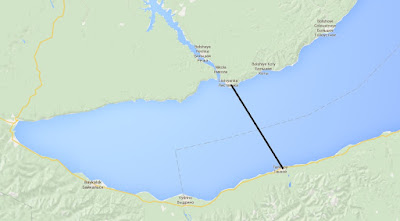 |
| The actual course wasn't nearly that straight. |
The plowed course was narrow. As a result, we began running single file with our left kept free as a passing lane. Over the first few miles, we sorted ourselves out, passing one another and being passed until we were more or less organized from fast to slow. The early part of the course offered a good running surface. The race crew had repeatedly plowed the track in days leading up to the race, leaving a dusting of snow over the ice. Perfect! I was zipping along, dreaming of the finish line and already congratulating myself on a job well done.
Five or six kilometers into the run, the course began to change. The wind was blowing snow back onto the track and we had to hop over small drifts. Not so bad. A few kilometers more and the track disappeared completely. We were quickly forced to abandon the “track” and bushwhack through ungroomed snow.
 |
| The start of the course. |
From there on—the last 20 miles of the course—it was tough going through ankle deep snow. Footing was suspect and nearly all of the runners, me included, fell into the trap of weaving back and forth searching for terra firma, or rather snowa firma, that simply wasn’t there. That translated into stumbling, twisting ankles, stubbing toes and putting leg muscles through torture.
It was unbelievably slow going. You could see forever, so, looking up, you’d perceive the snaky line of runners stretching ahead of you for miles. They were moving too, so you never got any closer to those objects on the horizon. In fact, because they were moving faster than you, you were falling farther behind. Occasionally, an unmoving, mirage-like object would appear on the horizon—one of the hovercraft that served as aid stations—and you would fixate on it like a castaway spotting a passing ship. Trouble was, it took ages, eons really, to reach that point. Once there, though, it was time to celebrate. That meant hoisting a glass of lukewarm tea with the Russians manning the station. Ваше здоровье! (To your health!) You could also help yourself to the odd assortment of goodies—chocolate bars, nuts, cheese—all frozen solid. Then it was back to the grind.
 |
| Mile 17. |
To dwell on the difficulty of the task, however, is to miss its magnificence. Lake Baikal is colossal. Standing in its midst, you are witness to an unvariegated plain of white. A few miles into the race, you are wholly enveloped by a sparkling void. Now and again, you would come across a patch of the black ice for which the lake is famous. Staring down into this hazy prism you might glimpse fantastic objects fossilized in the frozen mass, or perceive liquid water far, far below. It was then that you could fully appreciate your position, gliding along on a thin veneer of glass above nearly a mile of abyss. BIM’s unique admixture of brutal conditions and otherworldly beauty is what gives the event its mesmerizing appeal.
Somewhere past the half marathon point, the eastern shore became vaguely visible. With each slowly passing kilometer the outline of snowcapped mountains became clearer. With 10K to go, it was possible to make out the outline of our pink 1960s vintage hotel in Listvyanka. The finish line! Seeing it was literally cold comfort as I knew, at my present rate of progress, it would be a good two hours before I got there. Predictably, the going only got slower from that point forward. Not only was there no relief from the snow, but the wind picked up and we encountered sections where splintered chunks of ice lay just below the surface. Footing became more precarious.
 |
| In the hotel lobby after the race. The look says it all. |
I was beat, but my spirits were good. I began singly out loud to my iPod playlist. I’m not sure what other runners thought of my unaccompanied version of Mick Jagger, (“Star, f*** a star, fu*** a star, f*** a star.”) but no one seemed to mind. The language of love in universal.
No road goes on forever. I eventually arrived at the finish line, greeted by an adoring crowd of two Russians. I beat it to the hotel, found my luggage and spent a good 30 minutes under a cascade of hot water until my body temperature returned to normal. A little while later, I joined all the participants for a celebratory feast of tasty Siberian cuisine washed down by beer and toast after toast of водка (vodka).
Delightful.
I didn’t do this on my own. I owe thanks to many people for the great privilege of participating in this incomparable event. My enablers included Anna and Michael from the Sydney-based adventure travel agency 56th Parallel. My months of pestering questions were inevitably met with a reassuring “Don’t worry!” from Anna. That is sagacious advice for anyone visiting Siberia. (If you ever have a yen to travel to that uniquely wonderful part of the globe, 56th Parallel should be your first call.)
Absolute Siberia, the organizers of this event, rendered astonishing service, managing our meal and hotel accommodations, arranging for a small armada of buses, trucks, snowmobiles and hovercraft, preparing the course (even if there best efforts were undone by the Great Baikal), hosting the banquet and promoting good cheer. The race is ostensibly a charitable event meant to raise money to preserve the lake, but I suspect the economic windfall is small vis a vis the titanic effort it entails. Rather, I assume these warm and hardy Siberian folk simply enjoy sharing their wonderful environment and culture with outsiders capable of appreciating their magic.
 |
| The Absolute Siberia team scouting the ice before the race. |
Signing up for four days of pre-race training turned out to be a stroke of genius. It not only afforded me the opportunity of scouting the lake in advance of the race, it brought me under the wing of Arkadiy Kalikman, our trainer, veteran of every running of the Baikal Ice Marathon and three-time winner. He gave us loads of advice about taking on this challenge and urged us to be philosophic in accepting whatever came our way. “Man proposes. Baikal disposes.” I expected to experience the great lake, I had not thought I’d encounter a man who embodied its spirit in every fiber of his muscles and bones. What a joy! Now 68 years old, Arkadiy zipped past me at the 15 km marker and finished an hour ahead of me.
I also owe deep gratitude to the other six runners who took part in the BIM training program, Ed (UK), Sabrina (French from Moscow), Camel (Belgium), Alexander (German/Russian from Moscow), Alexander's French wife Oud (I’m sure I got that spelling wrong), and Pierre (France). We instantly became BFFs, did everything together and became mutual agents of encouragement and support. At the concluding banquet, when the finishers’ medals and tee-shirts were handed out, a clerical error caused me to be passed over. After going to bed, the others tracked down the race organizers, retrieved my goodies and presented them to me in the morning. What pals!
The beginning, middle and end of my support system is, of course, my beautiful, wonderful wife, Linda Rosner. She not only immediately approved of my plan to travel more than halfway around the world to run on a frozen lake, she encouraged it and facilitated every detail and step. I am the luckiest man alive.
My time: 6:44.
Original report is found here: http://mypolaradventure.blogspot.ru/2016/03/race-report-baikal-ice-marathon.html
Friday, March 4, 2016
A Bowl of Uhka at the Steam Bath
This morning after listening to a lecture on the aerobics of running from our guide Arkadiy, my Ice Marathon mates and I attempted to put theory into practice by making another assault on Lake Baikal. Yesterday afternoon, while I slept, a snow storm passed through leaving the ice covered in a blanket of fresh powder a foot deep. That turned our run into an awkward stumble. We soon gave up and reverted to tottering along on roads much to the annoyance of the local canines.
After reviving ourselves at lunch over bowls of uhka (fish soup), we headed for a steam bath located a little further east along the lakefront. This establishment featured a wooden sauna surrounded by expertly crafted ice sculptures. The sauna, which we were told the proprietor rebuilds each winter, was large enough to accommodate a dozen people and heated to a sweltering 95C.
The idea was to sit inside the hot room until you couldn’t take it any longer (ten minutes or so), then scamper down a short pier to a hut made of ice that enclosed a small pool filled with frigid lake water. Dive in, then return to the heat. The effect of the cold water was quite remarkable, The heart rate soared. Pores snapped shut. Certain anatomical parts shrank to the size of peas.
Once we’d gone through that routine three or four times, we retired to a yurt for hot tea and more uhka.
If you’re curious, you can make uhka at home. Simply heat an aquarium to boiling, add potatoes and carrots. Simmer 30 minutes and serve.
1 comment:
-
You certainly know how to have fun. : )











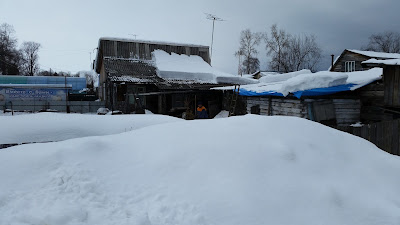
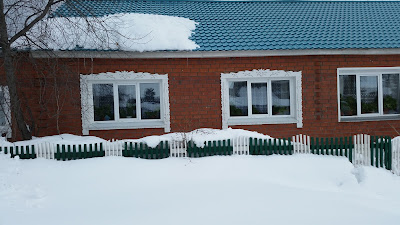
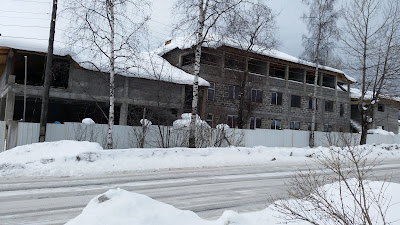


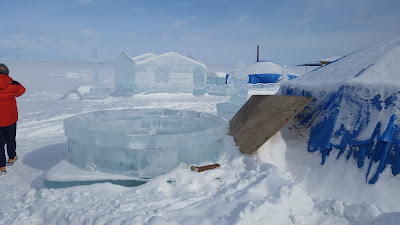





6 comments:
Such a pleasure reading your post Keith. Your writing draws you in for more. while it is impossible to really feel the pain and battles you went through during the race, reading it feels like you are there. You are an inspiration. Huge hello and well done from the team here in the Sydney office.
ReplyWhat an amazing adventure. Thank you for sharing.
ReplyAwesome trophy for an awesome adventure Keith. Well done!
Hey Keith, I am hoping to do the Baikal Ice Marathon in 2017 so your blog post is really handy! How many marathons had you done before this one - did you notice a significant difference between your usual running time and your finishing time here? I'm around a 5-hour marathon runner so I'm a bit leery that I will be on the ice for 6+ hours...also what did you wear? I'll be coming from Australia so I'm not really certain what the best cold-weather running gear is. Any tips would be most appreciated!
Hi Jeanne,
You will love this race. I recommend signing up for the training program, which is run by a gentleman named Arkady who is one of the originators of the race. It allows you to acclimate a bit, test your gear on the lake, meet interesting fellow runners and have great fun. I have done around 75 marathons/ultras. My typical time for a "normal" street marathon is 3:55. So, this was much longer! The main reason for that is that it had been snowing every day for a week before the race. The wind kicked new snow into the plowed race track obliterating it. So we had to trek 20 miles in snow 8 to 10 inches deep. It was crusty and uneven, making it impossible to run and very fatiguing. The race is also psychologically taxing. You are going very slow, can see a long way and feel you are making no progress. I wore three layers--thermal, fleece, wind-breaking jacket. More than enough for the conditions on the day. I felt a little cold late in the race...it was windy and maybe 5F near the end, and I was energy depleted. But it was manageable. It is impossible to predict weather conditions even a few days before the race. Your conditions are likely to be quite different from mine. You will likely fact different challenges, probably something you weren't expecting. I hadn't considered the cold. One more note on clothing. I wore a pair of Solomon winter running shoes with thick lugs, built-in gaiters, and built in metal spikes. They worked great, except that the spikes weren't particularly useful, as we were rarely on bare ice--the snow again. Don't miss this race! The experience of a lifetime. It is hard, but you don't need to be a super athlete to complete it--I'm not--you simply need raw determination. Good luck. I hope this helps. (See some of my earlier blog entries for descriptions of the training course.)
Thank you so much Keith, this is really helpful! I have my entry form completed and am waiting for entries to open so I can apply for the training program and race :)
Reply